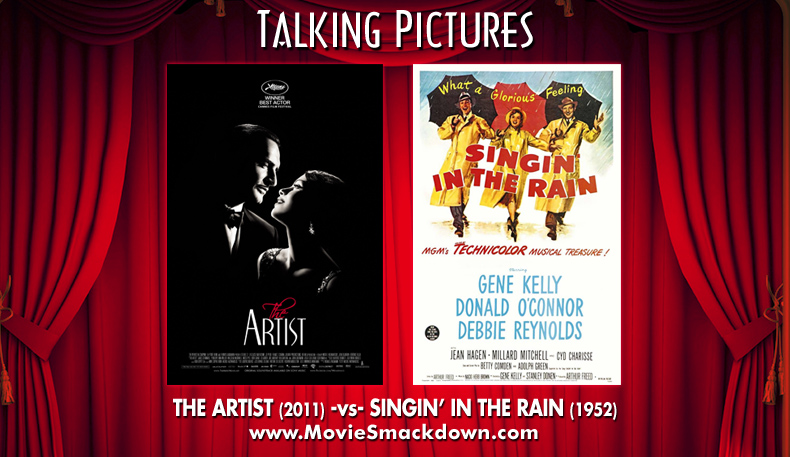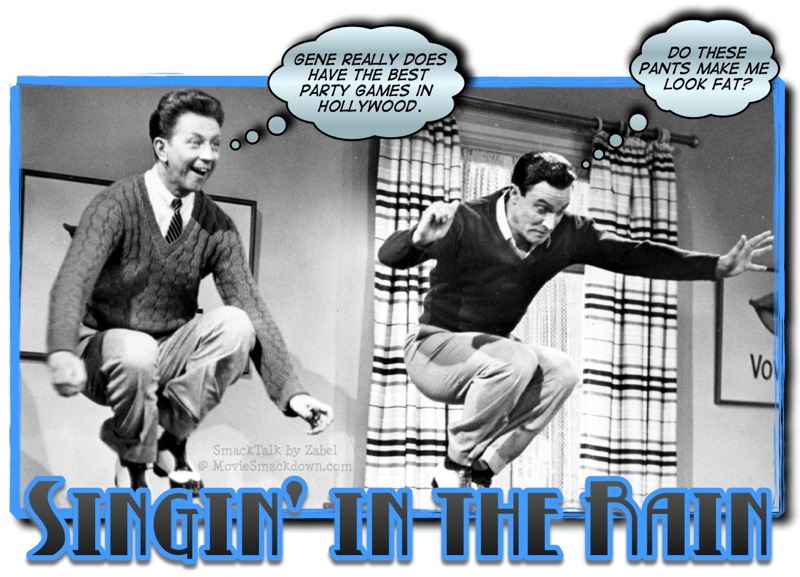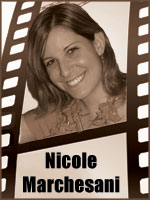
The Smackdown
Computer-generated effects, 3D, surround sound…. It’s hard to believe there was a time when the biggest challenge in filmmaking was incorporating the sound of characters talking. The 1952 classic Singin’ in the Rain pays homage to that task while showcasing some of the greatest song-and-dance of its era. With the introduction of talking pictures and color soon to follow, everyone in Hollywood jumped on the bandwagon, and silent, black-and-white films almost instantly became a thing of the past. Why would anyone want to return to such a time, when it was clear, even back then, there was no market for silent films?
Harvey…? Michel…? There’s your cue!
In case you haven’t heard, Harvey and Michel are promoter extraordinaire Harvey Weinstein and Frenchman Michel Hazanavicius, the writer/director of The Artist, who just sailed away from the 2012 Academy Awards with a boatload of Oscars. The Artist, Hazanavicius’ silent black-and-white film from late last year, has already made quite the cultural impact, even as Weinstein pushes to achieve a commensurate box office haul. But can it achieve the same kind of lasting effect on moviegoers as its rival, or should we stick with the classics and encourage filmmakers to keep looking forward instead of back?
 The Challenger
The Challenger
No need to get your ears checked; you heard right: The Artist managed to tell a story on film in 2011 with virtually no dialogue and a black-and-white print, and managed to cart home five Oscars in the process, including ones for best picture, director and leading man. Its story begins in 1927, with the silent film star George Valentin (Jean Dujardin) dazzling his audience at the premiere release of his newest picture. When the curtain closes, Valentin takes a bow with his co-star, Constance (Missi Pyle), but her time on stage is limited, as Valentin steals the limelight by performing tricks with his faithful dog Jack, the film’s comedy relief. The crowd loves Valentin and everyone knows it, including Al Zimmer (John Goodman), the producer.
While Valentin is busy working on his next project with chorus girl Peppy Miller (Bérénice Bejo), Zimmer learns of a new phenomenon, talking pictures, and decides he’s going to produce one of his own. He offers Valentin a role, but pride gets the better of the star, who’s not yet ready to let go of the silent pictures where he earned his glory. His career comes to a halt just as Peppy’s takes off like a rocket—she’s suddenly America’s most popular talking-film star. The spark between Valentin and Miller sets the romance in motion, but will it be enough to get Valentin back on his feet from a career that continues to spiral downward?
Hazanavicius has spoken of his fascination with the Hollywood of the 1920’s and said his goal from the beginning was to make a silent film to recreate and honor that era. He has described his purpose as fulfilling a desire give the director even more control over telling a film’s story. He set the film in the late ’20s, when talkies became popular, to give the film extra resonance.
 The Defending Champion
The Defending Champion
Two decades after the era of silent films ended, director Stanley Donen teamed up with Gene Kelly to tell the story of how silent film star, Don Lockwood (Kelly), makes the transition from silents to talkies. Don has a fairly easy time with the transition, unlike his co-star, Lina Lamont (Jean Hagen), whose voice could make any fella wish he were deaf. Don’s best friend and head of the studio’s music department, Cosmo (Donald O’Connor), and rising star Kathy Selden (Debbie Reynolds) help Don transform Don’s failing first talkie into a musical extravaganza. There’s only one minor problem. Their lead actress, Lina, can’t speak properly, sing or dance.
A similar problem occurred while shooting Singin’ in the Rain with Debbie Reynolds. She had little singing experience and no dance training. Reynolds satisfied Kelly’s vision of the part because she was the right age, 19, much younger than Judy Garland, who was also considered for the role. Ironically, Singin’ in the Rain helped turns Debbie Reynolds into a singing sensation, leading to hit songs in other films like “Que Sera Sera†and “Tammy.â€
The Scorecard
The question everyone’s asking is how on earth Hazanavicius managed to convince anyone to help him make a silent black-and-white film in 2011. How would it be marketed? And even if an audience gave it a chance, would a silent movie hold a modern audience’s attention for over an hour? Against all odds, The Artist was made, and those questions are about to be answered in a way that looks to be extremely satisfying for audiences and studio alike.
In The Artist, Hazanavicius creates voices for the characters with music and movement. Very rarely, inter-titles will appear, covering the screen with dialogue, but Hazanavicius shows us there are other ways to captivate an audience than by using words. It helps to work with performers like Jean Dujardin and Bérénice Bejo, who prove to be masters at revealing emotion through dramatic expression. Hazanavicius also follows Cosmo’s motto from Singin’ in the Rain: If you want to hold an audience’s attention, make ’em laugh. The gags in this film are clever, relevant and unexpectedly hilarious.
On the other side of the ring, the musical masterpiece, Singin’ in the Rain, produces some of the most spectacular dancing sequences ever captured on film. Donald O’Connor confirms he is Kelly’s dancing equal in the “Moses Supposes†number. He may not have Kelly’s dashing good looks (actually, The Artist’s Dujardin looks more like Kelly), but who cares about looks when O’Connor can flip off a wall and throw himself on the ground repeatedly without losing a beat?
As for Reynolds, it’s hard to believe she never had a dance lesson, moving at the same speed and precision as Kelly and O’Connor. With modern musicals, editors tend to make the dance numbers appear more exciting than they really are by using lots of cuts. Watch Christian Bale’s solo in Newsies for a prime example. There’s no need for this type of editing in Singin’ in the Rain. The numbers are long and uncut to show these dancers are really doing what we think they’re doing.
Even if you’ve never seen it, Singin’ in the Rain continues to influence pop culture. Popular television shows like Glee and The Simpsons have done renditions of the title song. Tom Hanks copies Kelly’s classic umbrella-dance in the 1988 film, Punchline. Joseph Gordon-Levitt even recreated O’Connor’s “Make ‘Em Laugh†number on Saturday Night Live, flips and all.
If there’s one flaw in the timeless classic, it’s the length of the film. Sorry, I may be under 60 years old, but the film begins to feel long around the time Cyd Charisse shows up to dance with Kelly. Not only does the scene feel forced in an attempt to bring Kelly together with Charisse, who was probably his female dancing equivalent at the time, but the dance hardly shows what the two are capable of achieving.
The Decision
While The Artist has been on everyone’s lips since the Oscars, it’s easy to forget that a few short months ago, Americans had never heard of anyone connected with the film. Still, it took viewers here by storm because it was completely unexpected and brilliant, not too long and laugh-out-loud funny. No easy task for any film, much less a silent. Singin’ in the Rain remains a classic and continues to amaze younger generations. The fact that it’s a musical helps keep the film alive and relevant. Hollywood has loved musicals since the first talkie, the Jazz Singer, and Singin’s as good as any of them. But Hazanavicius has taken an entire idiom that has been dormant for a century and brought it back to life. For that reason alone, The Artist deserves to win this Smackdown.



I am surprised by your decision to give The Artist the winning flag. Except the era of release of The Artist vs Singing in the Rain, I think singing in the rain entertains and holds on to you for much longer not to mention the dance sequences are fabulous. Though the Artist is comics and the gags are brilliant, the movie is a drag once Jean Dujardin is pride and disagrees to speak.
I saw Singing in the rain 10 months back and saw the Artist yesterday. Whereas, Singing.. intrigued me till the end, it was difficult to watch the Artist because I had seen Singing…
I finally got around to seeing THE ARTIST and I thoroughly enjoyed it. When I initially read your Smackdown I was surprised you selected THE ARTIST as the winner — but for all the reasons you give, it is the right decision. Keep up the good work.
Hey, Bob… Jackie and I just went as our daughter’s guest to the “Directors on Directing” panel at the Santa Barbara International Film Festival and heard Michel Hazanavicius speak.
As an interesting aside, he filmed all the scenes with music playing in the background for the actors. Must have been a fun set.
I also note that it is the only film that is nominated for Best Picture that was entirely shot in Los Angeles.
I loved Singin’ in the Rain and the acting ,dancing, and humor. I can’t wait to see The Artist. If it is anything as entertaining and colorful as your recount, then I know I am going to be leaving the theater with a smile.
The Artist is as colorful as a black-and-white can be!